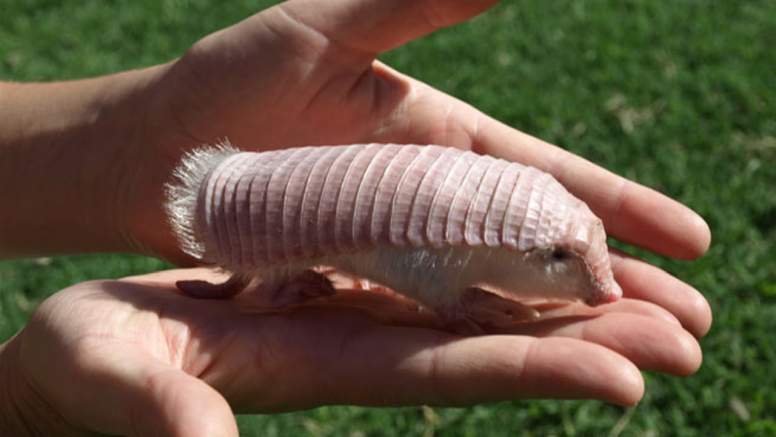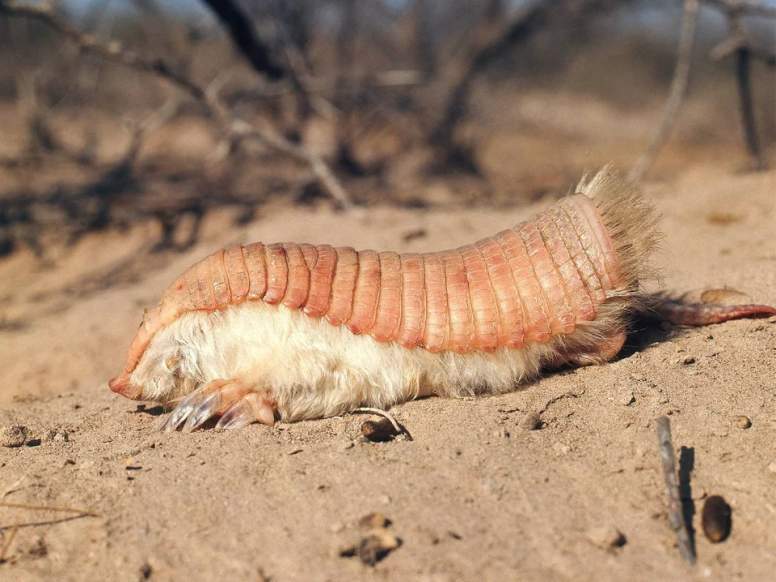Pink Fairy Armadillo Profile
The Pink Fairy Armadillo, or ‘pichiciego’ – is a desert-adapted mammal with a ‘pink’ bony armor shell, that is native to central Argentina. It inhabits sandy plains, scrubby grasslands, dunes and spends much of its time underground.
It’s the tinniest species of armadillo in the world and uses its surroundings not just for habitation, but to hide from many different threats. They are elusive and rarely ever seen by humans, and among the least known and studied armadillo species.

Pink Fairy Armadillo Facts Overview
| Habitat: | Sandy plains, grasslands, sand dunes |
| Location: | Central Argentina |
| Lifespan: | 5-10 years |
| Size: | 3.5 inches (90 millimeters) – 4.5 inches (115 millimeters) |
| Weight: | 120 grams (4 oz) |
| Color: | Pink & white |
| Diet: | Insects, worms, snails, plants |
| Predators: | Domestic dogs & cats |
| Top Speed: | 2 mph (3.5 kph) |
| No. of Species: |
1 |
| Conservation Status: |
Data deficient |
Pink fairy armadillos have a silky fur that is yellowish-white in color. They also have small eyes and a flexible dorsal shell. A thin dorsal membrane is what attaches the shell to the armadillo body. The blunt rear of the shell is where a spatula-shaped tail appears – coming from a vertical plate portion of the shell.
This mammal is nocturnal and solitary with a diet that is primarily insects, worms and snails. In particular, its main food source are ants and larvae. The pink fairy armadillo also eats various plant parts, but will only resort to vegetation when other food sources are not readily available.
The Mendoza region is known for having both warm and cold seasons along with wet and dry seasons. The temperature ranges are not extreme, which has allowed to pink fairy armadillo to adapt to them.
The average high temperature during the warm season would be near 30C with the cold season reaching just 15C. The average low would be just slightly above freezing.
The conservation status of the pink fairy armadillo is uncertain, and is listed as data deficient by the IUCN Red List of Threatened Species. These mammals have experienced a drastic drop in population over the past few decades. Farming activities have generally been pointed to as the main factor impacting the pink fairy armadillo population. However, predators including domestic dogs and cats have also been noted as contributing to the decline.
Field sightings are rare and individual pink fairy armadillos that have been captured in the wild tend to die within two days of being removed from their natural habitat. Only one that was held in captivity lived for more than four years.
The evolutionary distinctiveness of the pink fairy armadillo, their limited geographic territory, existing threats and rarity make strong arguments to suggest urgent conservation attention. Without it, this species of armadillo risk extinction. Especially considering their sensitive nature to the environment they inhabit. 1
Interesting Pink Fairy Armadillo Facts
1. The pink colour of their shell is due to a network of blood vessels underneath, which can be seen through the armor.
This is what gives the pink fairy armadillo shell its pink or pale-rose appearance.
2. The armored shell contains 24 bands that allow the pink fairy armadillo to curl up into a ball to protect its vulnerable soft underbelly.
While its shell is much softer than and more flexible than other armadillos, it still acts as armor.
 Photo credit Imgur.
Photo credit Imgur.
3. Of all armadillo species, the pink fairy armadillo is the only one whose dorsal shell is totally separate from its body.
It is connected to the body with only a thin membrane, which runs right along its spine.
4. Scientists believe the pink fairy armadillo shell helps with thermoregulation.
Since its blood vessels are so close to the surface, the armadillo can control the amount of surface area is exposed to the environment to gain or lose heat.
5. The pink fairy armadillo shell can change colour.
This is dependent on the environment and thermoregulation of the armadillo. Irrigation of the blood can increase into carapace of the shell to help lose heat and increase the ‘pink’ appearance. Conversely, it can drain blood from out of the shell to retain body heat which makes the shell colour paler.
6. It’s equipped with two massive sets of claws on its front and hind legs.
They serve as tools to assist with quickly digging burrows in compacted soil. A very rare video below captures a pink fairy armadillo doing what pink fairy armadillos do best: digging.
7. The pink fairy armadillo has earned an unusual nickname the ‘sand-swimmer’.
It was long presumed by biologists that they could ‘swim’ through sand like a fish swimming in a body of water. However, that is a myth, the pink fairy armadillo actually dig through sand using their claws.
8. The posterior portion of their shell, known as the ‘butt plate’ – is flattened, so that it can compress dirt behind it as its digging.
It does so to close the burrow behind it, and create more open space in front so it can breathe. Mariella Superina a biologist managed to capture this behaviour in a video below.
9. The claws of the Pink Fairy Armadillo make it hard to walk on hard surfaces.
Because of the size of the digging claws, which are actually large in comparison to the scale of the animal, they make walking on anything other than sand and soft surfaces very difficult.
10. Pink fairy armadillos are extremely sensitive to changes in environmental conditions and stress resulting from it can be devastating.
As they are classified as subterranean armadillos, any form of environmental change can have an impact on them including extreme changes in temperature or soil quality.
11. The desert-adapted characteristics of the pink fairy armadillo severely limits the type of habitat it can occupy.
In order for these mammals to survive, they require undisturbed regions that contain enough compact sand and hiding places for protection from elements and predators.
12. As a fossorial generalist insectivore, the pink fairy armadillo has a primary diet which is easily and quickly supplemented when required.
Ants and larvae that are located underground make up the main diet for this mammal and in instances when these food sources do not exist, the pink fairy armadillo will turn to plant leaves and roots.
13. With very small eyes, the pink fairy armadillo finds its way around in a unique manner that does not require vision.
The navigation skills of this animal come directly from touch and hearing.
14. The body of the pink fairy armadillo has a great deal to do with how it is able to move underground.
It has a torpedo-shape which reduces the amount of drag when burrowing underground.
15. The tail of the pink fairy armadillo is more than just an appendage that hangs from the rear of the body.
Because it is thick and hairless, the tail is used for balance and stability when all other limbs are being used for other tasks.
16. Rain presents life-threatening risks to the pink fairy armadillo.
Because it lives in burrows, during heavy rain the armadillo will vacate the underground to avoid being drowned. Plus, if it gets its fur wet, the pink fairy armadillo can’t properly thermoregulate and may develop hypothermia in the cooler hours overnight.
17. The pink fairy armadillo does not make a very good pet.
Oddly enough, on the black market, many of these mammals have been sold as pets. However, their low survival rate in captivity has greatly impacted that practice.
18. Climate change could virtually eliminate the entire pink fairy population.
Because they have very little body fat and a low metabolism rate, cold temperatures could result in the extinction of this animal. Habitat loss it already contributing to a decline in population.
19. Farming presents two very different risks to the pink fairy armadillo population.
In addition to farmland destroying burrows, the use of pesticide can impact the mammal. The pesticides adhere to the bodies of ants and as ants are one food source for the pink fairy armadillo, the more one ingests, the sicker it can get.
20. Hunters have also contributed to the decline in pink fairy armadillo population.
Pink fairy armadillos have been harvested for consumption for decades. The fact that they have a taste and texture that has been compared to pork has added to the endangerment.
21. They are so rare, nobody really knows their conservation status and whether they are an endangered species.
Mariella Superina a biologist for National Scientific and Technical Research Council of Argentina’s Conservation has been trying to assess their risk of extinction and in 13 years of field work has never seen a pink fairy armadillo in the wild. She has only seen tracks, which stop suddenly, and appear to be where the armadillo has disappeared underground. 2
Pink Fairy Armadillo Fact-File Summary
Scientific Classification
| Kingdom: | Animalia |
| Phylum: | Chordata |
| Class: | Mammalia |
| Order: | Cingulata |
| Family: | Chlamyphoridae |
| Subfamily: | Chlamyphoridae |
| Genus: | Chlamyphorus |
| Species Name: |
Chlamyphorus Truncatus |
Fact Sources & References
- “Pink Fairy Armadillo”, via ICUN Redlist
- “Pink armadillos ain’t your Texas critters”, via ScienceNews.
